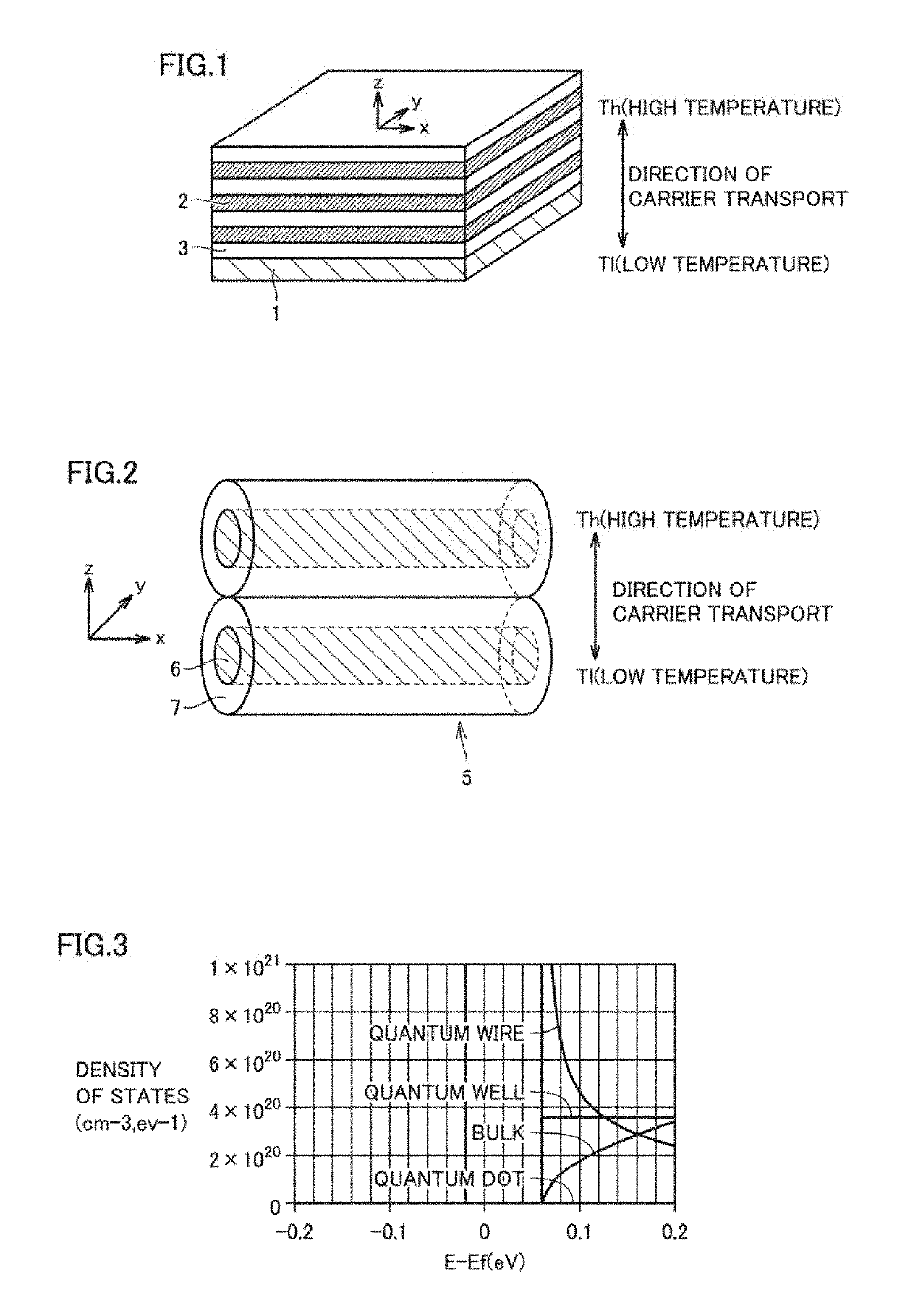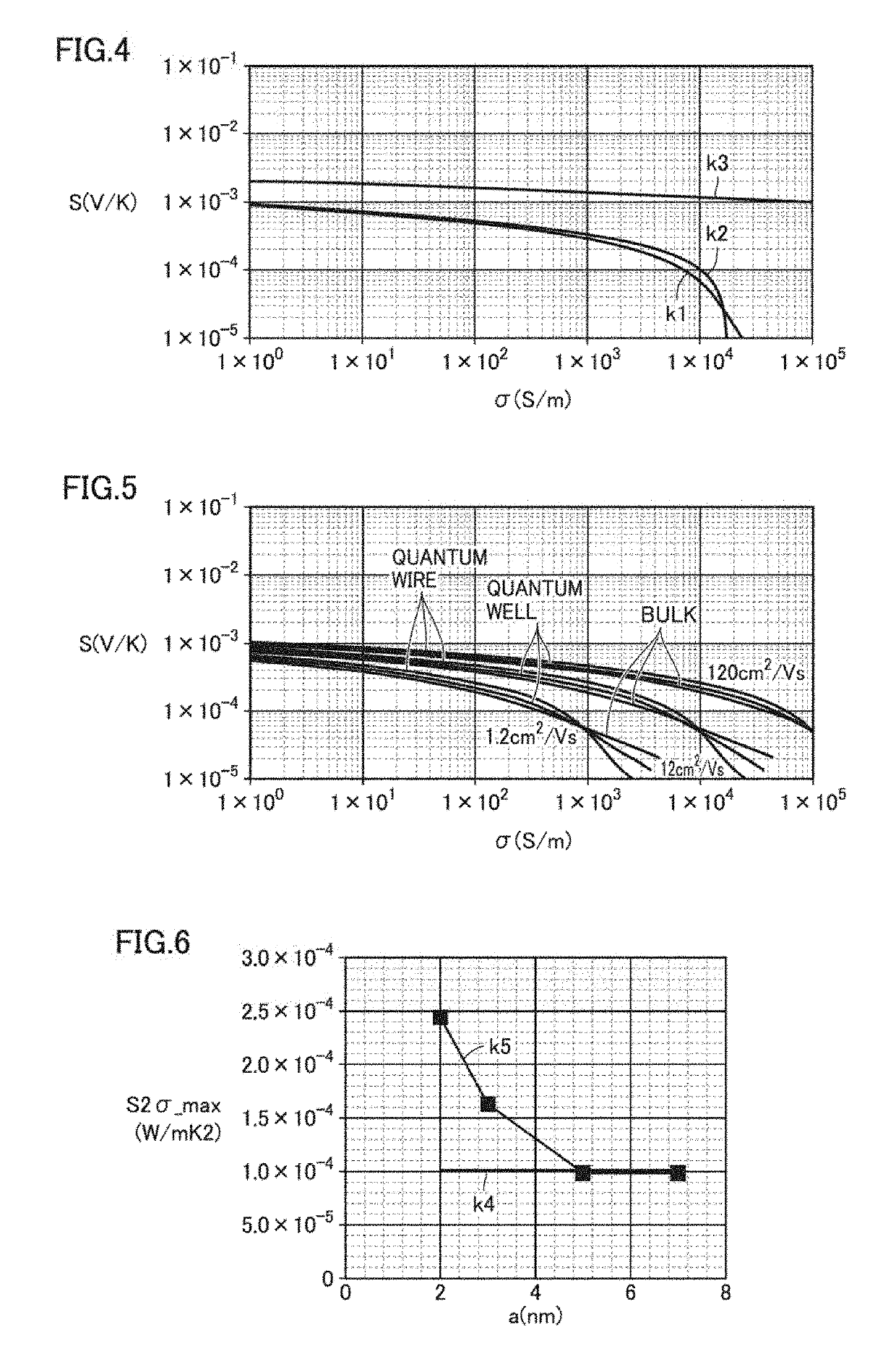Thermoelectric material, thermoelectric module, optical sensor, and method for manufacturing thermoelectric material
a technology of thermoelectric modules and thermoelectric materials, applied in the direction of thermoelectric device junction materials, thermoelectric device manufacturing/treatment, thermoelectric device with peltier/seeback effect, etc., can solve the problem that the conductivity of the thermoelectric material may be lowered, and achieve excellent thermoelectric characteristics
- Summary
- Abstract
- Description
- Claims
- Application Information
AI Technical Summary
Benefits of technology
Problems solved by technology
Method used
Image
Examples
first embodiment
[0080]A basic construction of a thermoelectric material according to this invention will initially be described. FIG. 1 is a perspective view schematically showing a thermoelectric material having a quantum well structure. FIG. 2 is a perspective view schematically showing a thermoelectric material having a quantum wire structure.
[0081]Referring to FIG. 1, a quantum well structure is formed by alternately stacking on a main surface of a substrate 1, two semiconductor layers 2 and 3 different from each other in band gap energy. Since semiconductor layer 2 is relatively low in band gap energy, it forms a quantum well layer. Since semiconductor layer 3 is relatively high in band gap energy, it forms an energy barrier layer.
[0082]The quantum well structure is a structure in which a state that an energy level is discretized can be obtained as an electron state around a valence band and a conduction band is quantized in a one-dimensional direction (for example, in a direction of a thickne...
second embodiment
[0115]In this embodiment, wave functions of carriers are combined between quantum dots by decreasing an interval between quantum dots (nanoparticles). A quantum dot structure is a structure in which a state that an electron state around a valence band and a conduction band is quantized in a three-dimensional direction and an energy level is discretized is obtained. The quantum dot structure can have discrete sub band structures not only in the z direction but also in the x direction and the y direction, and can achieve effective energy conversion. With this quantum effect of the quantum dots, transport of carriers between the quantum dots is allowed. FIG. 10 is a schematic diagram showing a construction of a thermoelectric material 20 according to this invention. In the description below, a quantum dot structure shown in FIG. 10 is also referred to as a “quantum network (net) structure.”
[0116]Referring to FIG. 10, in the quantum net structure, quantum dots (nanoparticles) 30 impleme...
third embodiment
[0162]A method for manufacturing a thermoelectric material according to this invention includes a stacking step of alternately stacking a first layer containing a different element and a second layer not containing the different element and an annealing step of forming nanoparticles in a base material by subjecting a stack of the first layer and the second layer to annealing treatment.
[0163]In the third embodiment, the stacking step is a step of alternately stacking the first layer and the second layer on a substrate body. Such a substrate body is preferably formed in such a manner that an uppermost portion thereof in contact with the first layer or the second layer is formed of a material capable of forming a solid solution of the different element. With such a construction, in diffusion of the different element through annealing treatment, the different element can diffuse also in the substrate body and precipitation of the different element as being concentrated in a specific por...
PUM
 Login to View More
Login to View More Abstract
Description
Claims
Application Information
 Login to View More
Login to View More - R&D
- Intellectual Property
- Life Sciences
- Materials
- Tech Scout
- Unparalleled Data Quality
- Higher Quality Content
- 60% Fewer Hallucinations
Browse by: Latest US Patents, China's latest patents, Technical Efficacy Thesaurus, Application Domain, Technology Topic, Popular Technical Reports.
© 2025 PatSnap. All rights reserved.Legal|Privacy policy|Modern Slavery Act Transparency Statement|Sitemap|About US| Contact US: help@patsnap.com



